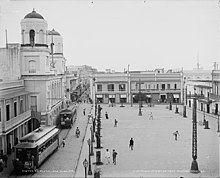Tren Urbano (San Juan)
The fully automated subway line in the Puerto Rican capital, San Juan , is called Tren Urbano ( Spanish ) or Urban Train ( English ) . The route, opened in 2005, is 17.2 kilometers long and has 16 stations. The subway is the only rail transport system on the island of Puerto Rico and the first subway system in the Caribbean.
The Tren Urbano San Juan has been part of the integrated bus system of the Autoridad Metropolitana de Autobuses since it opened . The entire local public transport is operated by the Alternativa de Transporte Integrado .
business
route
The Tren Urbano of San Juan currently consists of a single 17.2 kilometers long standard gauge line and comprises a total of 16 stations. All train stations are barrier-free, two train stations ( Rio Pedra and Universidad ) are underground.
- Bayamón
- Deportivo
- Jardines
- Torrimar
- Martínez Nadal
- Las Lomas
- San Francisco
- Centro Médico
- Cupey
- Carolina (planned)
- Río Piedras
- Universidad
- Piñero
- Domenech
- Roosevelt
- Hato Rey
- Sagrado Corazón
- San Mateo (planned)
- Minillas (planned)
- Avenida Todd (planned)
- Miramar (planned)
Tickets
A single ticket costs $ 0.75 and also includes the option to transfer to an AMA bus for two hours. Schoolchildren, college students, and seniors (60 to 74 years old) receive a discount and pay $ 0.35 per trip. Seniors over 75 years and children under 6 years travel free. Various season tickets are also available, and trips can be paid for with a rechargeable magnetic stripe card similar to the MTA in New York City .
vehicles
When the company opened, Siemens AG delivered 74 vehicles, each 23 meters long. Each car is air-conditioned and has 72 seats and 108 standing places. The trains have a top speed of 100 km / h, the cruising speed is around 33.2 km / h. The vehicles run as double multiple units and usually in triple traction . In the rush hour, 15 trains are required for operation. The trains are operated electrically with 750 volts direct current, with the power being supplied via a conductor rail.
history
Previous rail transport
In the late 19th century, when Puerto Rico was under Spanish rule, the island's first railroad was built, mostly along the coast. The railroad also played a major role in the first half of the 20th century, especially in sugar cane cultivation. There was also a tram network called Trolley de San Juan between 1901 and 1946 , operated by the Porto Rico Railway, Light and Power Company . The network had a length of about 32 kilometers between San Juan and Santurce and carried about ten million passengers per year.
In the 1950s, Operation Bootstrap caused a major industrial boom on the island and the sugar cane industry lost its status as the island's main industry. Due to increasing prosperity and increasing industrialization, the automobilization of the population also increased sharply, so that railway lines were no longer considered necessary. It was only towards the end of the 20th century that it became apparent that, in addition to the bus system, rail transport is needed to develop and solve the traffic problems on the island and, above all, in the capital San Juan.
Planning and construction
In 1967 there were first proposals for a rapid transit system in the Puerto Rican capital. But it was not until 1989 that the Puerto Rico Department of Transportation and Public Works took the plans more specifically. Under the Intermodal Surface Transportation Efficiency Act of 1991, the US Federal Transit Administration chose the construction project as a turnkey demonstration project - construction and maintenance should be done by a single company and consortium. The tender was won by the partners Siemens AG and Alternate Concepts , Inc. in July 1996, with numerous companies serving as suppliers to the group. It was the first of its kind in North America to include both construction and maintenance.
The construction of the rapid transit system began in 1997 and was marked by numerous delays, contractual disputes between the government and the companies, and public prosecutor's investigations into possible mismanagement. Construction costs totaled $ 2.28 billion.
opening
The San Juan rapid transit railway officially went into operation on December 19, 2004. From the opening until April 2005, weekend trips were free, then also on weekdays. By the end of the free journeys in June 2005, over 40,000 passengers used the rapid transit system every day. Commercial operations began on June 6, 2005, when the number of passengers dropped to around 24,000 passengers per day, less than a third of the forecast 80,000 per day. In 2006, around 28,000 passengers use the Tren Urbano on workdays, in 2007 around 27,500, and in 2008 around 36,500 per working day. As the further passenger numbers did not satisfy the government, they lowered the fare from $ 1.50 to $ 0.75.
Individual evidence
- ↑ Archived copy ( Memento of the original from May 20, 2011 in the Internet Archive ) Info: The archive link was inserted automatically and has not yet been checked. Please check the original and archive link according to the instructions and then remove this notice. FTA - The Predicted and Actual Impacts of New Starts Projects - 2007
- ↑ Tren Urbano PR another way low transit ridership forecast , TOLLROADSNews, November 20, 2005, accessed April 13, 2007
- ↑ Transit Ridership Report ( Memento of the original dated February 6, 2009 in the Internet Archive ) Info: The archive link was automatically inserted and not yet checked. Please check the original and archive link according to the instructions and then remove this notice. Third Quarter 2008, Heavy rail, accessed December 5, 2008



